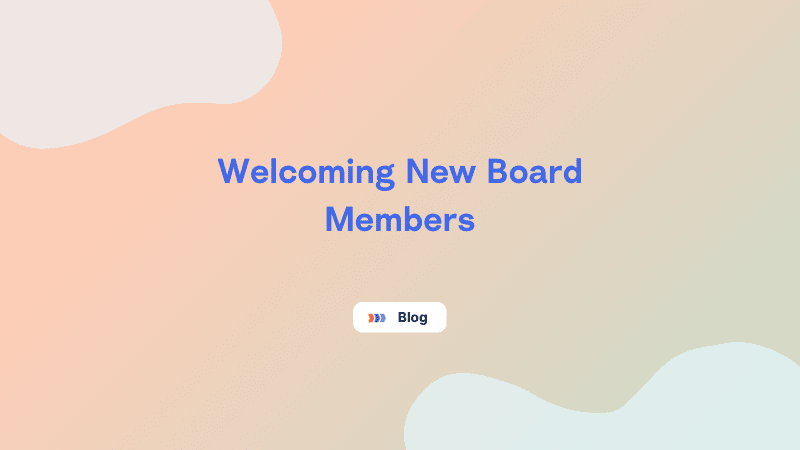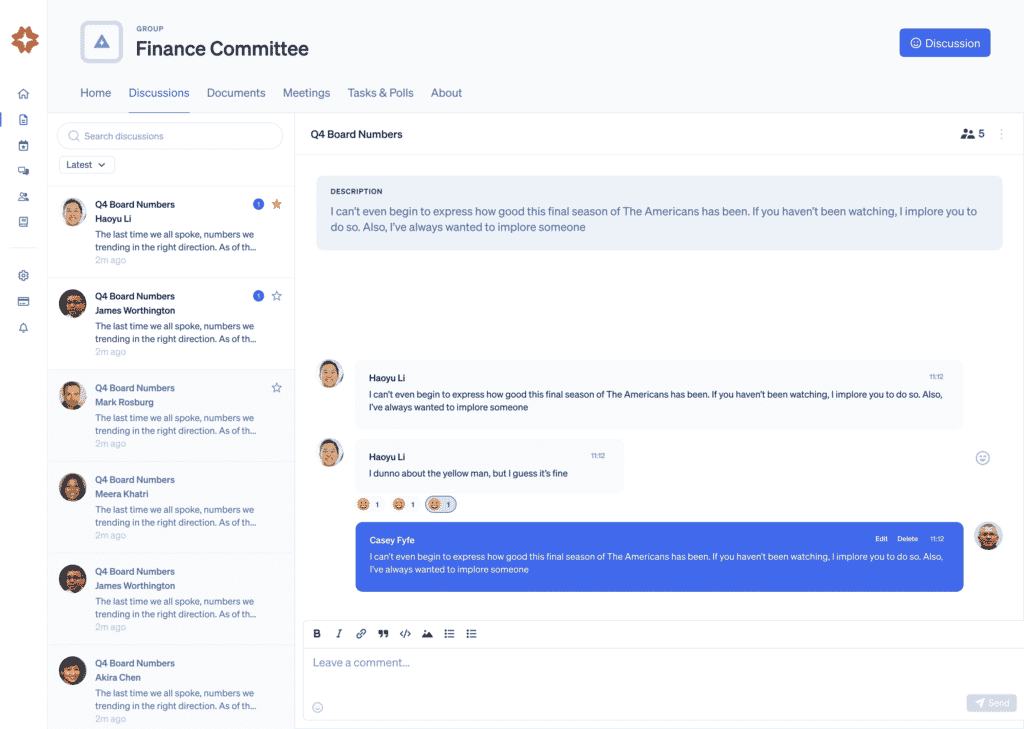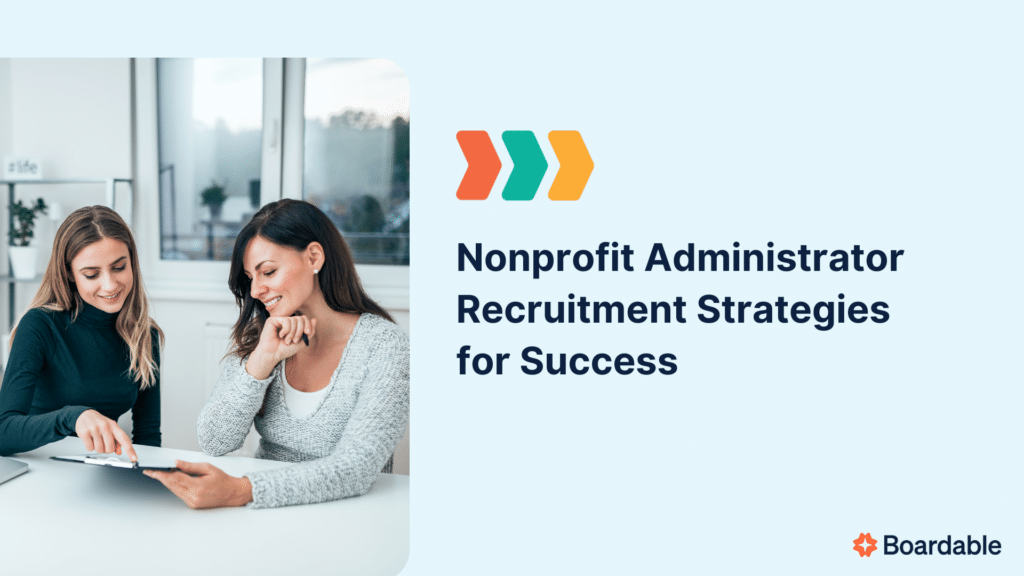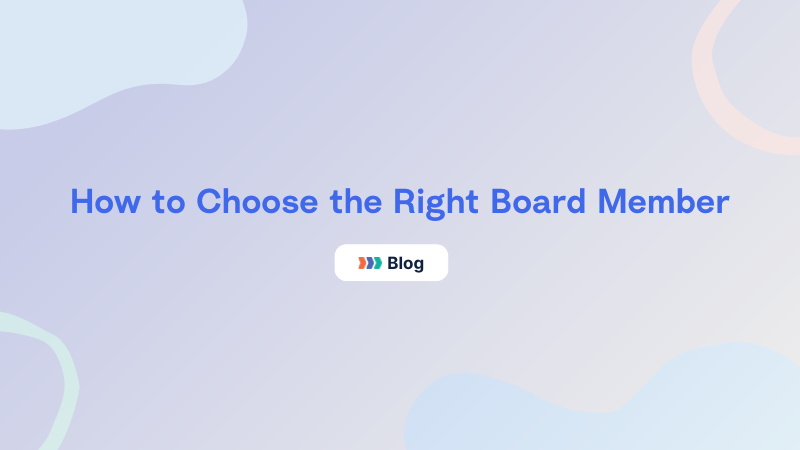As a board leader, you’re likely thrilled to welcome new board members. You can’t wait for them to join your team and help your organization on the path to success. Plus, your recruits are feeling just as excited as you are. They’re inspired and engaged, but how can you make sure they have everything they need to get started on the right foot?
Chances are, you have an onboarding process in place for new staff members that enables them to become acquainted with the team and get acclimated to your work quickly. So why not do this for new board members?
New members need to be caught up on a lot of information in a relatively short amount of time so that they’re able to hit the ground running. A welcome process that outlines current initiatives, who to contact for information, and your organization’s current goals allows new board members to catch on quickly. Solidifying an onboarding process will ease everyone’s transition into their new roles and ultimately set your entire organization up for success.
In this guide, we’ll answer key questions and provide powerful tips for enhancing the onboarding experience:
- How Do You Find New Board Members?
- How to Welcome New Board Members Before the First Meeting
- Holding a New Board Member Orientation
- Tips for New Board Members
- How Board Software can Simplify New Member Onboarding
When you’re working with stellar individuals, walking them through an onboarding program at your organization is relatively simple. You just need to help them fit in swiftly and easily with the rest of the team.
Before diving into the world of onboarding, grab your free copy of ‘The Board Engagement Playbook: 7 Tenets For Success’ where you’ll learn how to increase engagement for new AND old members. Jump back to this guide to explore how to create a successful onboarding experience that sets a positive tone for their entire term. Then, your free e-book will be ready for you when you’re finished, so you can learn about other aspects of effective board engagement. Let’s dive in!

How Do You Find New Board Members?
Before welcoming your new board members, you’ll need to first connect with the right people who are passionate about your mission and possess admirable qualities that will help support your work. Assembling an effective board sets a solid foundation for organizational growth and vitality, which is why it’s important to maintain a pipeline full of promising candidates.
As you get started, you may struggle to figure out where exactly you’ll find the right prospects. Here are the key first steps any organization should take when searching for new board members:
- Set up a nominating committee. Your first step is to assemble a group of trusted advisors who dedicate their time to assessing the skills your board needs. Put well-connected board members on this committee. Then, set them loose to locate a pool of qualified candidates. Many boards include this role in the governance committee since new board members are only needed as terms expire.
- Turn to your volunteers. These individuals are already connected and loyal to your cause. Serving on the board is just another opportunity to support your organization. Plus, they understand your organization’s backend processes, while other members may have only a general understanding of how things work.
- Analyze your donor database. Donors are also excellent candidates who are committed to your success. In particular, consider major and recurring donors, as these individuals demonstrate a consistent commitment to your cause. Further, these individuals tend to have excellent connections throughout the community and can help bring in other major donors.
- Broaden your search to the community. Go beyond existing advocates by considering prominent business leaders and outstanding volunteers at similar organizations. You might even take to social media or board recruitment websites (like LinkedIn for Nonprofits) to connect with individuals looking to lend a helping hand.
Nowadays, finding passionate board members is easier than ever. Not only do we have traditional tools that we can use (like word-of-mouth recommendations), but we also have an expansive online world with endless possibilities. By first taking a look at your organization’s network and then expanding to the broader community, you’ll attract a promising pool of new board member candidates.

How to Welcome New Board Members Before the First Meeting
New board members will get a formal introduction and welcome at the first official board meeting, but connecting with other board members before that initial meeting is crucial. The idea here is to make them feel like part of the team from the very beginning. Not only does this exhibit your board’s professionalism, but it also helps to establish camaraderie and to get everyone on the same page.
Taking the time to onboard your properly ensures that they will be thoroughly engaged, even if their first official meeting is later in the year. Let’s walk through four ways you can do this.
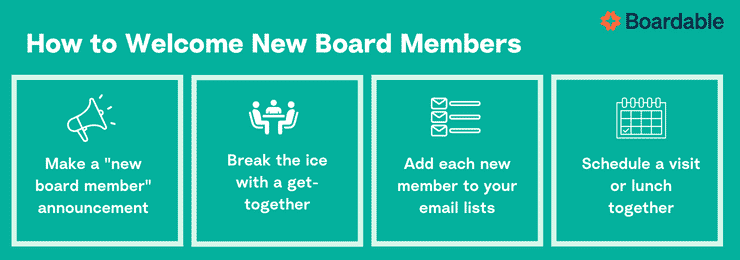
Make a “New Board Member” Announcement.
Extend a warm welcome to new board members by making a public announcement. Not only does this show them that you’re proud to have them on board, but it also informs supporters that you have new additions to your team.
Here are three primary platforms where you’ll want to share the news:
- In your newsletter: Your regularly-scheduled email newsletter is a fantastic opportunity to announce each of your members. Have each new individual write up a short bio stating their background experience as well as which positions they’ll be filling.
- On your website: Many organizations maintain an up-to-date page with current leadership and board members. Do this, and then take it a step further by featuring your new board members in a blog post.
- On your social media: Either share a single post showcasing the entire team or dedicate a post to each individual with their bio and a headshot. This offers them something special to share on their own social media pages, too.
Proactively and publicly welcoming new board members will kick things off on the right foot. These are just a handful of ways you can accomplish this, so experiment with different approaches to find what works best for your organization. It never hurts to ask what type of announcement your board members prefer.
Break the Ice with a Get-Together.
If possible, encourage your current members of the board and leadership team to get together with new board members to welcome them. Those initial connections and first impressions are vital, and icebreakers will give new members a friendly face when they visit your facility or join their first meeting. Including key team members (like your executive director, executive committee members, and committee chairs) ensures members have someone to turn to as they get acquainted with your organization.
A quick lunch or another informal but informative session can help kickstart their involvement and make them feel welcome and at home. Keep in mind that this may not be feasible for board members who prefer to stay remote, but all is not lost! You can go digital and host a virtual hangout using your board’s virtual management tools instead.
Add Them to Your Email Lists.
It seems obvious, but make sure you add new members to your own email contact list and other communication platforms to ensure they receive all pertinent information. If you maintain an online calendar, be sure to add them to it and invite them to any meetings so that they can plan appropriately.
A board management software tool like Boardable will make this a one-stop process. All you need to do is add them into the system where they can create an account. Then, they’ll have access to everything they need (like meeting information and discussion boards) in one convenient location.
Schedule a Visit.
If possible, invite each new board member to your facility for a brief visit. Meeting on-site before their first board session is beneficial for a few reasons. They can tour the facility, see the boardroom, meet staff members and volunteers, and watch your team in action.
There is a lot to learn when you agree to serve, so an informal meeting allows your new arrivals to get up and running for their first board session.
Be sure to offer virtual tours for any new board members who prefer to stay remote. Line up a meeting using your board’s scheduling tools and hop on a quick call where you walk new board members around and answer any of their questions. Or, you could simply film a video ahead of time and share it with the team.

Holding a New Board Member Orientation
Some organizations host a separate board orientation meeting for new board members prior to the first official meeting, while others lump it into the first meeting. It’s up to you, but a separate meeting to go over your mission, review expectations, and fill out any necessary paperwork is often the better option.
First of all, most organizations underestimate the length of time a board orientation will take. Secondly, this meeting sets the foundation for moving forward, so it’s worth taking an hour or two to start off on the right track. These new board members are your organization’s future leaders, after all.
You might even choose to conduct a few team-building exercises among your new board members to start building camaraderie and help them get comfortable working in a group.
Assign a “Board Buddy.”
Joining a board can be overwhelming. New board members might feel intimidated to speak up with their questions in front of seasoned professionals, and they might feel out of the loop until they’ve been around for a bit. Consider assigning a mentor to help them navigate the first few meetings.
Choose an existing, continuing board member to help each new arrival settle in. Ideally, this person will:
-
Meet with the new board member one-on-one
-
Touch base before the first few meetings
-
Follow up afterward to answer any questions
When done correctly, this can be an enjoyable experience for the mentor as well. This gives them an outlet to share their passion for the mission and may reinvigorate their enthusiasm for their work.
Create a New Board Member Welcome Packet.
When you bring on a new board member, documents are always part of the onboarding process. While you want to provide them with sufficient information, you certainly don’t want to inundate your newest board member with reams of paper. Don’t run the risk that they’ll run screaming from the building after reading that 100th budget spreadsheet.
Share a new board member welcome packet with straightforward background materials that the individual can take home, read, ponder, and formulate questions around. Strike the perfect balance and help them get oriented quickly by sharing key documents like:
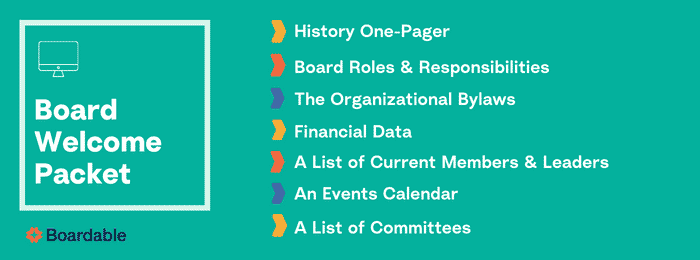
- History one-pager: This outlines your organization’s history. You can start by cutting and pasting background information from your website. Then, tweak it to be inspirational for your new board members.
Board roles and responsibilities: This covers what duties are assigned to each role on the board. Roles vary across organizations, but a few common ones are president, treasurer, and secretary.
- Organization bylaws: A copy of your bylaws will give new members a foundational understanding of their role in the decision-making hierarchy at your organization.
- Financial data: This can include financial information like your approved budget for the year and the most recent financial audit results.
- List of current leadership and board members: This should include a brief bio, a photo, and contact information for each of your nonprofit’s leaders and residing board members.
- A calendar: This lists upcoming meetings and events—either programmatic or development-related. Including this allows them to mark their calendars and gives them ample time to suggest updates if something was missed.
- A list of committees and their charges: Name your nonprofit’s committees and correlated responsibilities. You should also list committee members’ names and contact information.
We suggest providing these documents to new board members in a three-ring binder or housing this information within your board solution. With Boardable, you can go paperless and create a board orientation group where you store all these documents digitally. That way, new board members will have this information at their fingertips—no need to rifle through tons of paperwork to find what they need.
Walk Through Expectations and Responsibilities for Each Role
Once you’ve tackled introductions, you can move on to discussing roles, responsibilities, and expectations for the new members. Ensuring each new board member understands exactly what their role entails is essential for making progress toward your mission.
Start by providing a description of basic board member expectations. Many organizations develop a board member conflict of interest policy or a questionnaire if potential conflicts exist, and now is the perfect time to review it. In particular, you’ll also want to let the board members know about any expectations regarding their participation in fundraising efforts.
Then, dive deeper into each role by discussing specific roles’ day-to-day responsibilities. For instance, your secretary is responsible for keeping minutes, maintaining corporate records, and scheduling board meetings. Meanwhile, your treasurer is responsible for controlling finances like paying bills on time and ensuring the organization’s funds are properly invested.
Communicating this upfront will help avoid confusion later on and ensure everyone’s living up to expectations.

Tips for New Board Members
Serving on a board provides an incredible opportunity for personal and professional growth. It is, however, a demanding experience, especially when you’re brand new to the team.
Remember that as a board leader, it’s up to you to provide board members with the necessary resources to succeed. As part of your onboarding experience, don’t leave them to their own devices. Instead, equip them with tried-and-true tips for effective decision-making. Encourage new board members to transition into seasoned contributors by reminding them to:
- Honor commitments. Make sure your new board members don’t overcommit. Instead, they should focus on learning about the board and how board members work best together. When they do take on a task, they should follow through, which is when a task management tool can serve as a gentle reminder and help keep things organized.
- Be prepared. Communicate from the start that board members are expected to come prepared to meetings, instead of simply showing up to grace everyone with their presence. This includes following up on any assigned tasks as well as reviewing the agenda and any correlating documents.
- Build relationships. Building trust is critical to a board’s success, and that means cultivating relationships. New board members need to proactively build relationships with their fellow board members outside of the boardroom.
- Speak their minds: New board members tend to be more reserved because they don’t want to cause dissonance in the boardroom—especially among seasoned directors. Remind them that they’ve been brought on board to contribute because your team values their perspectives. So long as they do sufficient research on the topic at hand, they’ll be prepared to provide informed and insightful comments.
Supporting new board members by sharing tips like these will convey that you care about their experiences and want them to enjoy their time as a part of your team. In no time, they’ll become contributing board members who exceed expectations and confidently share their insightful opinions.
How Board Software Can Simplify New Member Onboarding
Becoming a new board member can be somewhat stressful, but one aspect members shouldn’t feel stressed out about is your board management software. Start new board members’ terms on the right foot by leveraging easy-to-use software that reduces the learning curve and can help people get up and running in their new roles quickly.
Luckily, board platforms like Boardable offer all of the tools that organizations need to simplify new board member onboarding. Some board management tools that will streamline your team’s responsibilities and processes include:
- A Document Center to host all new member onboarding documentation in a centralized location.
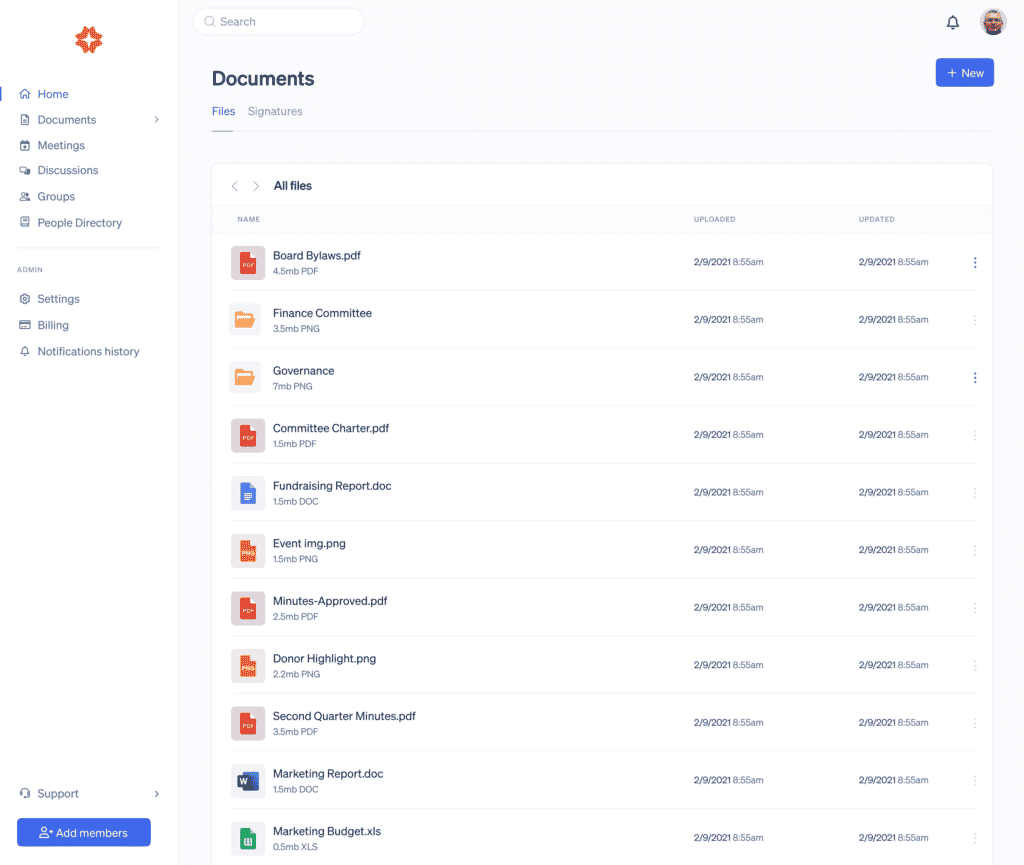
- Spotlight, which is our fully integrated online meeting platform for hosting virtual meetings with your team.
- An E-Signatures feature to sign any agreement forms in a convenient online format.
- Polling tools that allow you to gather new board members’ opinions on everything from the types of social opportunities they want to see to their favorite team t-shirt design.
These board management tools will not only help streamline new board member onboarding, but also provide a centralized, organized platform to manage board meetings, voting processes, and other pertinent activities on an ongoing basis.
